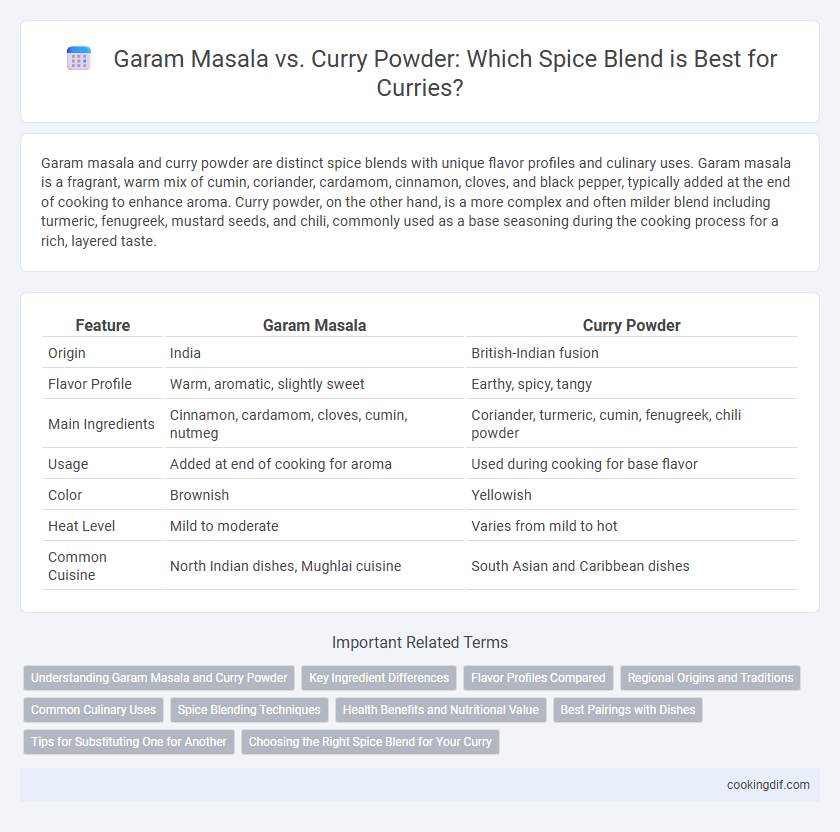Garam masala and curry powder are distinct spice blends with unique flavor profiles and culinary uses. Garam masala is a fragrant, warm mix of cumin, coriander, cardamom, cinnamon, cloves, and black pepper, typically added at the end of cooking to enhance aroma. Curry powder, on the other hand, is a more complex and often milder blend including turmeric, fenugreek, mustard seeds, and chili, commonly used as a base seasoning during the cooking process for a rich, layered taste.
Table of Comparison
| Feature | Garam Masala | Curry Powder |
|---|---|---|
| Origin | India | British-Indian fusion |
| Flavor Profile | Warm, aromatic, slightly sweet | Earthy, spicy, tangy |
| Main Ingredients | Cinnamon, cardamom, cloves, cumin, nutmeg | Coriander, turmeric, cumin, fenugreek, chili powder |
| Usage | Added at end of cooking for aroma | Used during cooking for base flavor |
| Color | Brownish | Yellowish |
| Heat Level | Mild to moderate | Varies from mild to hot |
| Common Cuisine | North Indian dishes, Mughlai cuisine | South Asian and Caribbean dishes |
Understanding Garam Masala and Curry Powder
Garam Masala is a North Indian spice blend typically made from warming spices like cinnamon, cloves, cardamom, cumin, and black pepper, prized for its aromatic and complex flavor profile. Curry powder, a British invention inspired by Indian cuisine, usually combines turmeric, coriander, cumin, fenugreek, and mustard seeds, providing a vibrant yellow color and a milder, earthier taste. Understanding the distinct spice compositions and regional origins of garam masala and curry powder helps in choosing the right blend for authentic flavor in Indian dishes.
Key Ingredient Differences
Garam masala primarily consists of warm spices like cinnamon, cloves, cardamom, and cumin, emphasizing aromatic depth and heat without hot chili peppers. Curry powder typically includes turmeric, coriander, cumin, and fenugreek, providing a bright yellow color and earthy, mildly spicy flavor due to the presence of dried chili or mustard seeds. These key ingredient differences shape their distinct taste profiles and culinary applications in Indian cuisine.
Flavor Profiles Compared
Garam masala offers a warm, aromatic, and slightly sweet flavor profile with spices like cinnamon, cloves, cardamom, and cumin, creating a complex and rich taste. Curry powder blends typically feature turmeric, coriander, cumin, and fenugreek, delivering a bright, earthy, and mildly spicy flavor with a hint of bitterness. The choice between garam masala and curry powder depends on whether a deeper warmth or a vibrant, tangy spice profile is desired in the dish.
Regional Origins and Traditions
Garam masala originates from North Indian culinary traditions, characterized by a warm, aromatic blend of spices such as cinnamon, cardamom, cloves, and cumin, reflecting the region's preference for rich, complex flavors. Curry powder, popularized by British colonial influence, is a standardized blend inspired by South Asian spice mixtures but adapted for Western tastes, often including turmeric, coriander, and fenugreek for a milder, earthier profile. Regional origins define garam masala as a fresh, roasted spice mix tailored for finishing dishes, while curry powder serves as a pre-mixed seasoning for stews and sauces, highlighting differing culinary uses and cultural heritages.
Common Culinary Uses
Garam masala is typically used in Indian dishes like curries, lentils, and rice for its warm, aromatic flavor profile, enhancing meats and vegetables with a complex spice blend. Curry powder, a British invention inspired by Indian cuisine, offers a milder, earthier taste suited for quick, flavorful sauces, stews, and soups. Both spices serve distinct culinary roles, with garam masala often added at the end of cooking and curry powder used during the cooking process for balanced seasoning.
Spice Blending Techniques
Garam masala and curry powder are essential spice blends in Indian cuisine, each with distinct profiles and uses. Garam masala is typically a warm, aromatic mix of spices like cinnamon, cardamom, cloves, and cumin, added towards the end of cooking to preserve its fragrance, while curry powder combines turmeric, coriander, cumin, and fenugreek, imparting a robust flavor earlier in cooking. Mastering the timing and method of toasting whole spices before grinding enhances the depth and complexity of both blends, highlighting their unique spice layering techniques.
Health Benefits and Nutritional Value
Garam masala and curry powder differ significantly in their spice compositions, impacting their health benefits and nutritional profiles. Garam masala typically combines warming spices like cinnamon, cardamom, and cloves, known for their antioxidant and anti-inflammatory properties, promoting digestion and metabolism. Curry powder often contains turmeric, which provides curcumin, a potent anti-inflammatory compound with immune-boosting effects, making it a valuable addition to a nutritious diet.
Best Pairings with Dishes
Garam masala's warm, aromatic spices like cinnamon, cloves, and cardamom best complement rich dishes such as chicken tikka masala, lamb curry, and butter chicken. Curry powder, with its bright, earthy turmeric and coriander notes, pairs well with vegetable curry, lentil dishes, and seafood stews for a milder, vibrant flavor. Selecting between garam masala and curry powder depends on the desired intensity and depth, enhancing the harmony of traditional Indian recipes or fusion creations.
Tips for Substituting One for Another
When substituting garam masala for curry powder, start with a smaller amount due to garam masala's more intense aroma and focus on warming spices like cardamom and cloves. Adjust seasoning gradually to maintain balanced heat and flavor, as curry powder typically includes turmeric and coriander, imparting earthiness and color. Combining herbs like cumin or turmeric can enhance garam masala as a curry powder stand-in, ensuring a closer match in complex spice profiles.
Choosing the Right Spice Blend for Your Curry
Garam masala offers a warm, aromatic profile with spices like cinnamon, cloves, and cardamom, ideal for finishing dishes with a complex flavor. Curry powder, a British invention, is a milder blend featuring turmeric, coriander, and cumin, better suited for seasoning during the cooking process. Selecting between garam masala and curry powder depends on the desired intensity and timing of spice infusion in your curry preparation.
Garam Masala vs Curry Powder for spice blending Infographic

 cookingdif.com
cookingdif.com